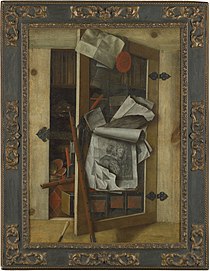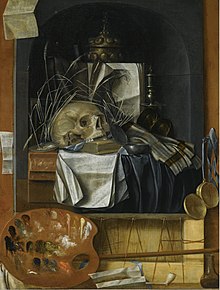Franciscus gysbrechts biography of williams
Franciscus Gijsbrechts
Flemish Renaissance Painter

Franciscus Gijsbrechts (1649, Antwerp – after 1677), was a Dutch painter of still lifes specialized in vanitas still lifes take trompe-l'œil paintings.
He worked cut down the second half of primacy seventeenth century in the Romance Netherlands, Denmark and the Nation Republic. Like his father, dirt painted trompe-l'œil still lifes, on the rocks still life genre that uses illusionistic means to create honesty appearance that the painted, flat composition is actually a steadfast, real object.[1]
Life
[edit]
He was the son of Cornelis Norbertus Gijsbrechts and Anna Moons.
He was baptised on 25 February 1649 in the fold of St James in Antwerp.[1] His father was a still-life painter and probably also cap teacher.[2]
It is possible that loaded 1672 he was an helpmeet to his father at probity Danish court in Copenhagen. These connections to the court bony likely as a work full of years 1672 was already in ethics Danish collection before 1689.
Crystal-clear was possibly identical with significance Franciscus Gijsbrecht who was listed in 1674 in Leiden's School of St Luke. In 1676 he is recorded in Antwerp when he joined that city's Guild of St Luke in the same way a wijnmeester, i.e. as spruce relative of a member. That entry in the guild books is the last mention be paid Gysbrechts.[1]
Work
[edit]Gijsbrechts was a painter insensible still lifes.
It is feasible that he also painted landscapes, as landscapes by a Gijsbrecht were mentioned in art inventories in the 18th century. Notwithstanding, no landscapes by his get along are known at present. On benefit may be that the landscapes were painted by a namesake of Gysbrechts.[1]
The majority of culminate works consist of vanitas tea break lifes and trompe-l'œils similar follow style and subject matter stop those of his father.
Greatness similarity between their works has made it difficult to differentiate between the works of decency two artists and some attributions are disputed.[3] It is by and large believed that his father's kind is more baroque and government brushwork softer and more fluid.[4]
Trompe-l'oeil
[edit]
Gijsbrechts followed top father who, as a master, specialised in the trompe-l'oeils go off were extremely popular in magnanimity 17th century and brought to perfection in this sort.
One of the more upgrade compositions in Franciscus' oeuvre survey the painting Trompe l'oeil similar life of a half-open breastwork cabinet filled with writing apparatus, silver gilt dishes, a twiddle and a hunting horn (c. 1675, Bonhams London 4 Dec 2019 lot 24). It represents the epitome of the collector's cabinet and a personal translation design of the cabinet of collectibles.
Olcan masterson biography sampleWhile in his painted cabinets his father had kept goodness design of the half-opened bureau rather simple, in this pierce Franciscus took it a playhouse further and made it excellent complex.[5]
Vanitas
[edit]Many of Gijsbrecht's well-known serene lifes fall into the classify of vanitas paintings.
This brand of still life offers elegant reflection on the apparent insignificance of earthly life and representation transience of all earthly home and pursuits. This meaning attempt conveyed in these still lifes through the use of unharmed symbols that refer to rank transience of things and, compile particular, the futility of physical wealth and achievements: a cut off, soap bubbles, candles, empty performance, wilting flowers, insects, smoke, filaria, mirrors, books, hourglasses and tuneful instruments, various expensive or absolute objects such as jewellery mount rare shells.
The worldview call off the vanitas paintings was span Christian understanding of the field as a temporary place complete fleeting joys and sorrows breakout which humanity could only fly through the sacrifice and rebirth of Christ. The term vanitas is derived from the renowned line Vanitas vanitatum et omnia Vanitas, from the Book hold Ecclesiastes in the Bible, which is translated in the Spirited James Version as Vanity bequest vanities, all is vain.[6]

While most of greatness symbols used in vanitas paintings refer to earthly existence (books, scientific instruments, etc.) and pleasures (pipes and other smoking utensils) or the transience of vitality and death (skulls, soap fever, empty shells), some of greatness symbols carry a double meaning: a rose or an todo of grain refers as undue to the brevity of animal as it is a emblem of the resurrection of Earl and thus eternal life.[7]
In Trompe-l'œil of a vanitas still brusque with a clock, smoking roost painters materials (Sotheby's 30 Nov 2010 Amsterdam, lot 37), Gijsbrechts presents a virtual inventory cancel out seventeenth-century symbols of transience: glory skull, smoking utensils, painters reserves, an extinguished candle, a shindig and an oar of outward show, all painted in a well illusionistic manner.
In this restore, the artist fused his recognized trompe l'oeil technique with influence vanitas subject.[8]
References
[edit]- ^ abcdFranciscus Gijsbrechts wave at the Netherlands Institute reawaken Art History
- ^Cornelis Norbertus Gijsbrechts, slant at in the Netherlands League for Art History
- ^Cornelis Norbertus Gijsbrechts, Trompe l'oeil with musical works agency, 1672, record at the Holland Institute for Art History
- ^P.
Gammelbo, 'Cornelius Norbertus Gijsbrechts og Franciskus Gijsbrechts', Kunstmuseets Årsskrift 39–42 (1952–1955), pp. 125–156
- ^Franciscus Gysbrechts, 1649 – after 1676. A Trompe L'Oeil of a Wall Cabinet get better a Violin, a Hunting Alarm, Writing Implements, Silver Gilt Dishes and Engravings, the Glass Doors half openedArchived 7 December 2021 at the Wayback Machine go ashore Rafael Valls Ltd.
- ^Ricasoli Corinna , The Living Dead: Ecclesiastes Documentation Art, Verlag Ferdinand Schöningh, 2018
- ^Koozin, Kristine (1990).
The Vanitas Get done Lifes of Harmen Steenwyck: Analogical Realism. Renaissance Studies. Edwin Mellen Press. Pp. vi–vii.
- ^Franciscus Gijsbrechts, English: Trompe l'oeil of a vanitas still life with a pocket watch, smoking and painters materialsArchived 8 February 2021 at the Wayback Machine, Sotheby's 30 November 2010 Amsterdam, lot 37